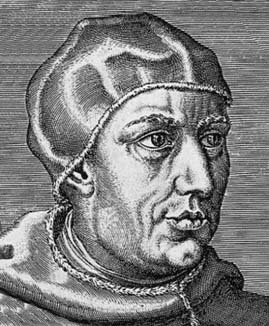Michael Stifel facts for kids
Quick facts for kids
Michael Stifel
|
|
|---|---|

Contemporain gravure of Michael Stifel
|
|
| Born | 1487 |
| Died | April 19, 1567 |
| Nationality | German |
| Alma mater | University of Wittenberg |
| Known for | Arithmetica integra (containing an early version of logarithms) |
| Scientific career | |
| Fields | Theology, mathematics |
| Institutions | University of Jena |
Michael Stifel (1487 – April 19, 1567) was a German monk and a key figure in the Protestant Reformation. He was also a very clever mathematician. He started as an Augustinian monk and later became an early supporter of Martin Luther. Stifel eventually became a professor of mathematics at Jena University.
Contents
Michael Stifel's Life Story
Stifel was born in Esslingen am Neckar, a town in southern Germany. He joined the Order of Saint Augustine and became a priest in 1511. He caused some stir when he published a poem supporting Martin Luther in 1522. Because of this, he left the abbey and moved to Frankfurt.
He soon went to Mansfeld, where he started studying mathematics. In 1524, Martin Luther recommended Stifel to the Jörger family. He worked for them at Tollet Castle in Austria. However, due to problems in Austria, Stifel returned to Wittenberg in 1527. During this time, he began writing a book that collected letters from Martin Luther.
Stifel's Prediction and New Role
With help from Martin Luther, Stifel became a minister in Lochau (now Annaburg). Luther also approved his marriage to the widow of the previous minister. Michael Stifel was very interested in numbers. He studied number theory and numerology, which is the study of the hidden meaning of numbers.
In 1532, Stifel published a book where he predicted that Judgement Day would happen on October 19, 1533, at 8 AM. When his prediction did not come true, he stopped making such forecasts. This event led to a German saying, "to talk a Stiefel" or "to calculate a Stiefel." It means to say or calculate something in a very unusual or incorrect way.
Teaching and Studying Mathematics
In 1535, Stifel became a minister in Holzdorf, near Wittenberg, and stayed there for 12 years. He studied important math books like "Die Coss" (the first algebra book in German) by Christoph Rudolff. He also studied Euclid's Elements, a famous book about geometry.
A scholar named Jacob Milich encouraged Stifel to write a big book about arithmetic and algebra. In 1541, Stifel enrolled at the University of Wittenberg to learn even more about mathematics. Later, in 1558, Stifel became the first professor of mathematics at the new University of Jena.
Michael Stifel's Math Discoveries
Stifel's most important book was Arithmetica integra, published in 1544. This book introduced many new ideas in mathematical notation.
New Ways to Write Math
- Multiplication: It was the first time in Europe that multiplication was shown by just putting numbers next to each other, without a special symbol. For example, instead of 2 x 3, he might just write 2 3.
- Exponents: He was the first to use the word "exponent" for the little number that tells you how many times to multiply a number by itself (like the '2' in 5²). He also showed rules for calculating powers, such as:
* When you multiply numbers with the same base, you add their exponents (e.g., q² * q³ = q⁵). * When you divide numbers with the same base, you subtract their exponents (e.g., q⁵ / q² = q³).
Early Ideas of Logarithms
His book also had a table of numbers and powers of 2. Some people think this was an early version of a logarithm table. Stifel clearly explained that you could turn multiplication and division problems into simpler addition and subtraction problems using these number series. He even used negative exponents in his examples. He knew this idea was very powerful, saying that "marvelous books could be written" about it.
Solving Quadratic Equations
Stifel was the first to have a standard way to solve quadratic equations. These are equations where the highest power of the variable is 2 (like x² + 3x + 2 = 0). He could solve different types of these equations by using both positive and negative numbers. He called his method AMASIAS, which was a step-by-step rule for solving these equations.
Understanding Negative and Irrational Numbers
In Arithmetica integra, Stifel also talked about negative numbers. At that time, many people thought negative numbers were strange or "absurd." But Stifel used them just like any other numbers. He also discussed irrational numbers (like the square root of 2, which cannot be written as a simple fraction). He wondered if they were "real" numbers or just made-up. However, he found them very useful and necessary for mathematics. He also explored methods for finding roots of higher powers using binomial coefficients.
See also
 In Spanish: Michael Stifel para niños
In Spanish: Michael Stifel para niños


